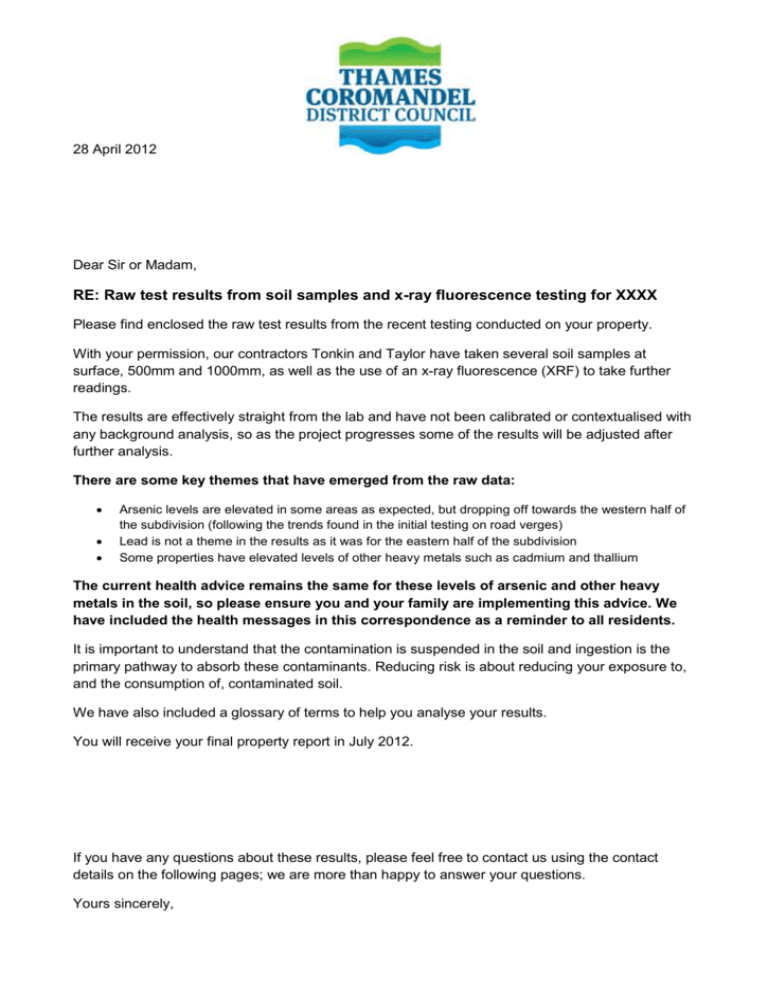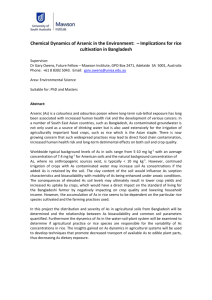Health advice - Thames-Coromandel District Council
advertisement

28 April 2012 Dear Sir or Madam, RE: Raw test results from soil samples and x-ray fluorescence testing for XXXX Please find enclosed the raw test results from the recent testing conducted on your property. With your permission, our contractors Tonkin and Taylor have taken several soil samples at surface, 500mm and 1000mm, as well as the use of an x-ray fluorescence (XRF) to take further readings. The results are effectively straight from the lab and have not been calibrated or contextualised with any background analysis, so as the project progresses some of the results will be adjusted after further analysis. There are some key themes that have emerged from the raw data: Arsenic levels are elevated in some areas as expected, but dropping off towards the western half of the subdivision (following the trends found in the initial testing on road verges) Lead is not a theme in the results as it was for the eastern half of the subdivision Some properties have elevated levels of other heavy metals such as cadmium and thallium The current health advice remains the same for these levels of arsenic and other heavy metals in the soil, so please ensure you and your family are implementing this advice. We have included the health messages in this correspondence as a reminder to all residents. It is important to understand that the contamination is suspended in the soil and ingestion is the primary pathway to absorb these contaminants. Reducing risk is about reducing your exposure to, and the consumption of, contaminated soil. We have also included a glossary of terms to help you analyse your results. You will receive your final property report in July 2012. If you have any questions about these results, please feel free to contact us using the contact details on the following pages; we are more than happy to answer your questions. Yours sincerely, Benjamin Day, Communications Manager On behalf of the Moanataiari project team Next steps Residents and homeowners will receive their final reports in July 2012. In the meantime, please put into practice the health advice. Stay in touch Please feel free to come to the weekly Community Forum meetings held every Thursday at 3.30pm at the Moanataiari Primary School. Bring your questions and we'll make sure they're answered. Please visit www.tcdc.govt.nz/moanataiari for more information and to read the project updates. Subscribe to our project eNewsletter by emailing ben.day@tcdc.govt.nz with your email address (we send out weekly updates). Health advice While waiting for the full report on soil testing in Moanataiari, the Ministry of Health advises people who may be concerned about protecting their health, to follow the advice in its pamphlet: Arsenic and Your Health. A copy can be found at a Thames Coromandel District Council Service Centre or online at: http://www.health.govt.nz/yourhealth-topics/arsenic-and-health The pamphlet includes specific advice for people who may live on mine tailings that may be high in arsenic, and this advice also applies to other contaminants: The Ministry of Health advises residents to: take care with personal hygiene (i.e. hand washing after handling soil); make sure children don't eat or play in soil; remove footwear before going indoors to avoid carrying soil dust indoors - particularly for households with very young children; cover soil (e.g. grassing, paving, gravel) to reduce dust and direct access by young children; not to eat home grown fruit and vegetables, especially young children, until further quantification of the contamination is available and the risk can be assessed, unless it is known that the garden soil is clean fill. don’t be concerned about the drinking water supply, it is separate (and safe); as always, if unwell for any reason, see your doctor. Glossary of terms As = Arsenic Cd = Cadmium Cr = Chromium Cu = Copper Hg = Mercury Ni = Nickel Pb = Lead Zn = Zinc Sb = Antimony Ti = Thallium <LOD = below Limit of Detection Mg/kg =Milligrams per kilo (parts per million) Acceptance criteria = This refers to any national standards or guidelines for that element Level of detection = this is the lowest reading the laboratory equipment can detect Sample locations = location where the sample was taken (maps will be provided in July with the final reports) "As Error, Cd error etc" = margin of error Laboratory results = results from soil samples analysed offsite at a lab Portable XRF results = results from the XRF machine QA results = results that have been checked (Quality Assurance), which gives a percentage difference between lab results and XRF results. This will be further expanded on when the data is analysed. Key contacts Thames-Coromandel District Council For general and media enquiries: Benjamin Day, Communications Manager; Ph: 07-868-0200 ben.day@tcdc.govt.nz or please visit www.tcdc.govt.nz/moanataiari Waikato Regional Council Soil testing and science related enquiries: Dominique Noiton, Programme Manager Water, Air & Waste 0800 800 401 Media enquiries: Stephen Ward, Senior Communications Advisor, Ph: 07 859 0782, Stephen.Ward@waikatoregion.govt.nz Waikato District Health Board General enquiries: For general public health enquiries please contact the Health Protection Unit on 07 838 2569 Personal health enquiries: Please contact your local GP or Medical Centre; they have been briefed by the District Health Board and will be able to assist you with personal health enquiries.







